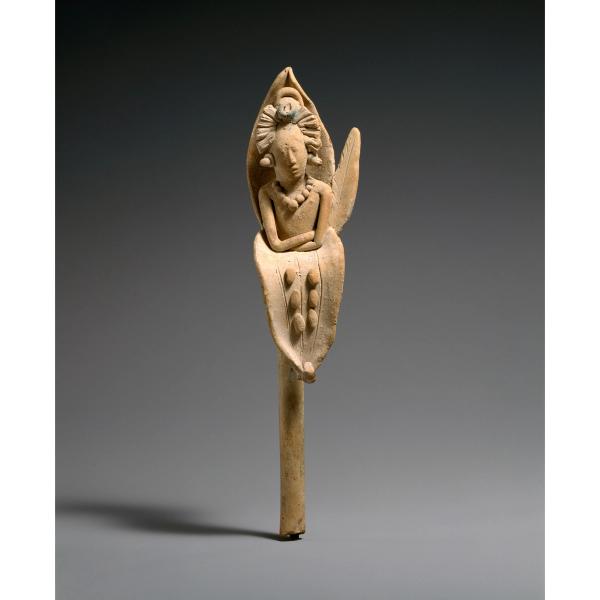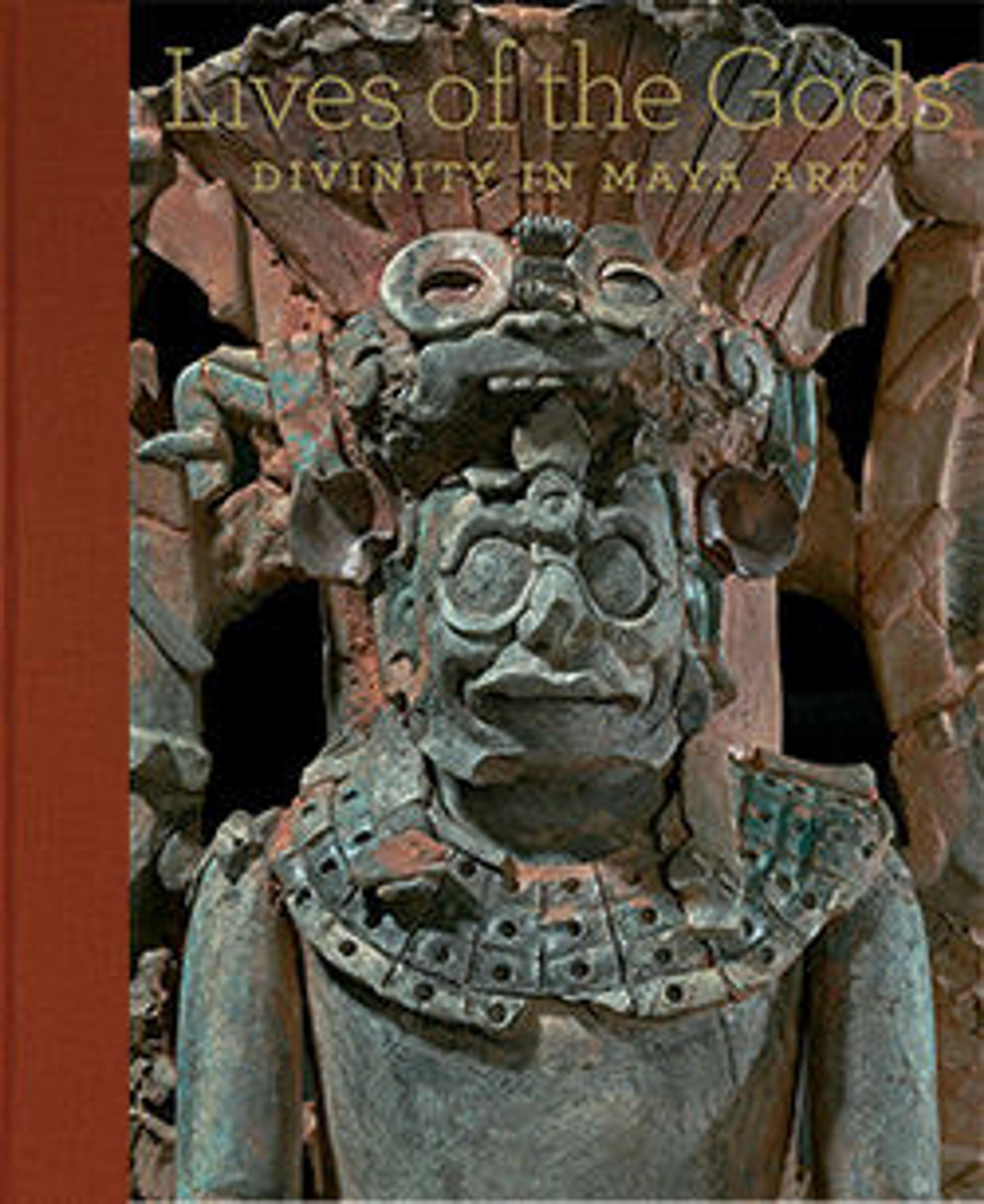Whistle with the Maize God emerging from a flower
The ear of corn sprouts from a long, narrow stem that is unadorned except for some minor areas of extant blue pigment. A tall, almond-shaped leaf stands upright behind the figure with three vertical lines gently incised on its outer surface (the back of the sculpture); another leaf of similar shape and size folds gently down in front to reveal six grains of corn arranged in two parallel vertical rows visually separated by three incised lines. A third blade-like leaf, shorter and narrower than the others, projects diagonally from the proper left side of the sculpture.
This object is probably from Jaina Island (present-day Campeche) in Mexico. It bears striking similarities to other hand-modeled Jaina figurines and effigies that depict deities emerging from flowers or other vegetation. While the depiction of identifiable deities is relatively uncommon in Jaina figurines, this sub-group of Jaina sculpture seems to portray gods exclusively.
References and Further Reading
Finamore, Daniel and Stephen D. Houston. 2010. Fiery Pool: The Maya and the Mythic Sea. Salem, MA: Peabody Essex Museum and New Haven: Yale University Press. Pl. 16, Pp. 58-61.
For comparanda and original definition of this subgroup of Jaina figurines, see:
Miller, Mary Ellen. 1975. Jaina Figurines: A Study of Maya Iconography. Princeton: Princeton University Art Museum. Figs. 22-24, p. 52.
O'Neil, Megan E. 2012. Jaina-style Figurines. In Ancient Maya Art at Dumbarton Oaks (edited by Joanne Pillsbury, Miriam Doutriaux, Reiko Ishihara-Brito, and Alexandre Tokovinine), 398-430. Washington, D.C.: Dumbarton Oaks Research Library and Collection.
For comparanda:
Finamore, Daniel and Stephen D. Houston. 2010. Fiery Pool: The Maya and the Mythic Sea. New Haven: Yale University Press and Salem: Peabody Essex Museum. [Pp. 60-61, Pls. 15, 16]
Schmidt, Peter, Mercedes de la Garza, and Enrique Nalda. 1998. Maya. Milan: Rizzoli/Bompiani. [p. 593, Pls. 299, 300]
Artwork Details
- Title:Whistle with the Maize God emerging from a flower
- Artist:Maya artist(s)
- Date:600–900 CE
- Geography:Mexico, Mesoamerica, Campeche, Jaina Island(?)
- Culture:Maya
- Medium:Ceramic, Maya blue and hematite pigments
- Dimensions:H. 8 1/8 x W. 2 x D. 1 1/2 in. (20.7 x 5.1 x 3.8 cm)
- Classification:Ceramics-Sculpture
- Credit Line:The Michael C. Rockefeller Memorial Collection, Bequest of Nelson A. Rockefeller, 1979
- Object Number:1979.206.728
- Curatorial Department: The Michael C. Rockefeller Wing
Audio

1632. Silbato con el Dios del Maíz brotando de una flor, artista(s) maya(s)
Laura Filloy Nadal
JOSÉ MARÍA YAZPIK (NARRADOR): Estos objetos de cerámica están decorados con un color inusual. Observe de cerca la delicada figura que emerge de una mazorca de maíz; en su tocado podemos ver restos de un pigmento azul. Laura Filloy Nadal, Metropolitan Museum of Art.
LAURA FILLOY NADAL: El azul maya es un pigmento distintivo y suntuoso creado por los antiguos mayas crearon. Es un logro tecnológico notable. Se trata de un pigmento artificial que se obtiene al mezclar el tinte de planta índigo, que actualmente se utiliza para teñir mezclilla, con una arcilla especial, la paligorskita.
La paligorskita es una arcilla natural con nanotubos en su estructura. Se obtiene en un sólo yacimiento de la zona maya, ubicado en la Península de Yucatán.
Con el uso de calor, esta arcilla se combina químicamente con el tinte y al secarse se convierte en parte de la arcilla. Es así como se produce el azul maya uno de los pigmentos más duraderos de Mesoamérica.
JOSÉ MARÍA YAZPIK: Los mayas consideraban que el azul y el verde eran un solo color, llamado "yax", que simbolizaba la humedad, la fertilidad y el lujo. El dios del maíz está íntimamente conectado con estos conceptos.
LAURA FILLOY NADAL: Esta delicada figura humana está emergiendo, del interior de unas hojas, como una mazorca de maíz o el pistilo de una flor. En esta pieza la deidad está en una posición inmóvil, con los brazos cruzados.
Aquí, el dios del maíz te mira fijamente. Se le representa como una metáfora de un nuevo crecimiento y regeneración. Observe como su cuerpo está pintado con pigmento rojo brillante.
En la cabeza de esta joven deidad se oculta una cámara o mecanismo de silbido. Cuando el aire era soplado a través del tallo que es hueco, se podría escuchar un sonido, probablemente agudo.
[SONIDO DE SILBATO]
JOSÉ MARÍA YAZPIK: En sus ceremonias, los mayas usaban, y usan actualmente, sonidos para convocar a las divinidades, solicitando su intervención sobrenatural.
More Artwork
Research Resources
The Met provides unparalleled resources for research and welcomes an international community of students and scholars. The Met's Open Access API is where creators and researchers can connect to the The Met collection. Open Access data and public domain images are available for unrestricted commercial and noncommercial use without permission or fee.
To request images under copyright and other restrictions, please use this Image Request form.
Feedback
We continue to research and examine historical and cultural context for objects in The Met collection. If you have comments or questions about this object record, please contact us using the form below. The Museum looks forward to receiving your comments.
